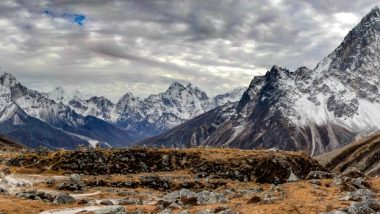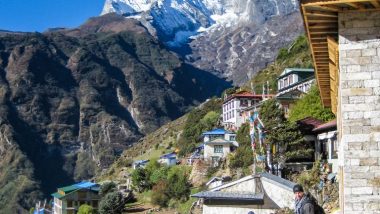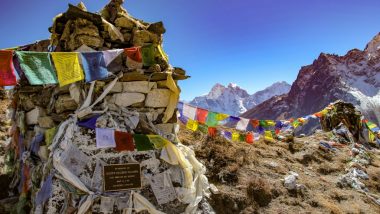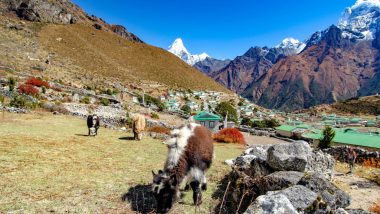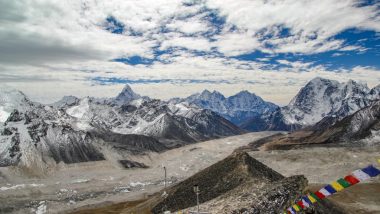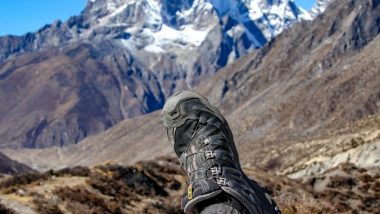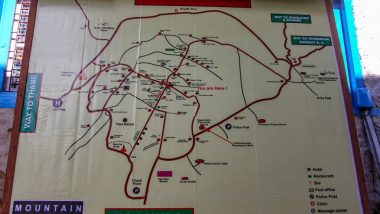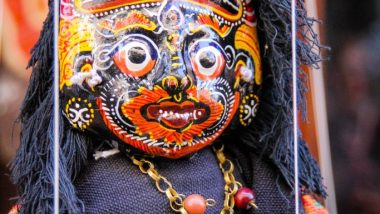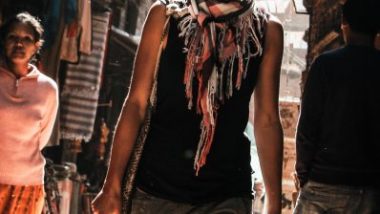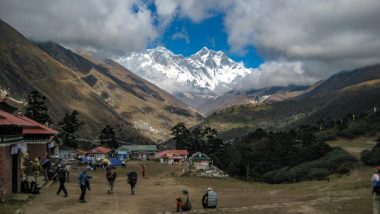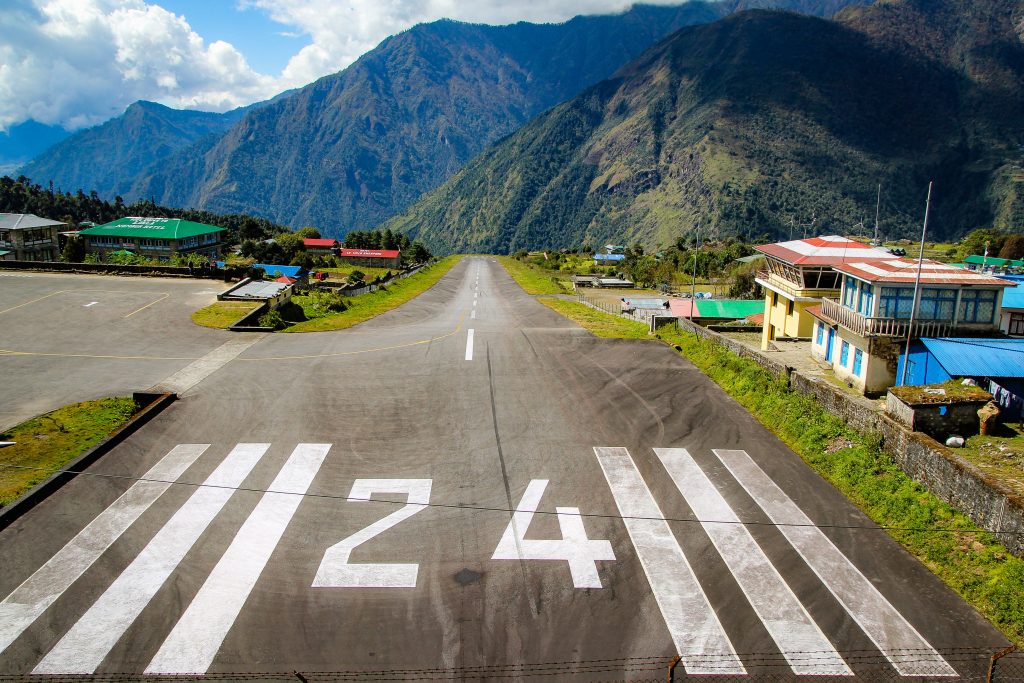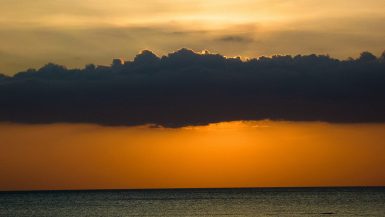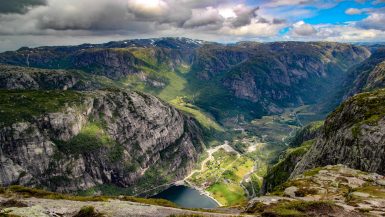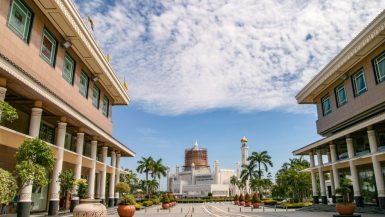Three month journey
Nepal has long been a must-do on our bucket list.
In 2010 we took some serious time off and we went on a three month journey covering India, Nepal, Bhutan, South Africa, Swaziland and Mozambique.
Everest Base Camp
Our main goal in Nepal was the trek up to Everest Base Camp (EBC).
A 14 day trek through what has to be some of the most beautiful scenery on the planet. It is absolutely breathtaking.
Kathmandu to Lukla
First you have to take a 40-min flight from Kathmandu to Lukla.
Lukla is a small village built on the side of the mountain. Altitude, 2860 m (9383 ft) above sea level.
This is where the vast majority start their ECB-trek.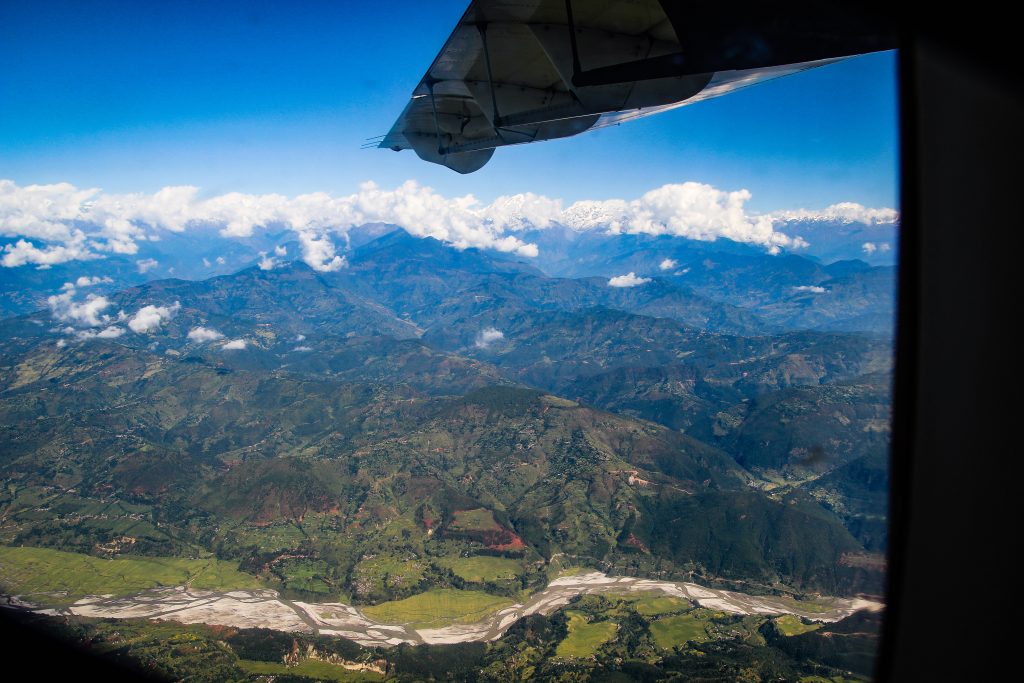
Flight alternatives
“But, what if I am afraid of flying. Will it impossible to do the EBC-trek?”
No, not really, But it will take you a week to get there on foot.
So if you are on a tight schedule, then flying is probably a good option.
Cancelled flights
Lukla airport is by many considered as one of the most dangerous airports in the world.
And for me, who were quite afraid of flying at that time, it was a bit of an “adventure”.
Our flights were cancelled three times due to bad weather before we could go.
Not cancelled for a later flight the same day. No, we had to come back three days in a row to finally have enough luck with the weather so we could take off.
My flying nervs had a couple of rough days to say the least.
Despite all the waiting and going back and forth, we were lucky. Some people we met had only two weeks of vacation and the weather situation made them cancel the trek completely, which must have been awful.
If you plan on doing the trek, make sure you have enough time, so unforeseen events like these will not ruin your holiday.
Small airplane and an even smaller airfield
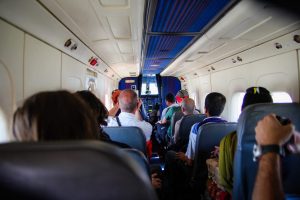 The small 15-18 seat airplanes that fly to Lukla can only be flown by pilots who are very experienced in short-takeoff-and-landings (STOL).
The small 15-18 seat airplanes that fly to Lukla can only be flown by pilots who are very experienced in short-takeoff-and-landings (STOL).
The Himalayan weather can change in an instant, so many times flights can be cancelled in mid-air and the planes have to return to Kathmandu again.
As the pilots rely solely on visual navigation for take-off and landing they are dependent on good weather conditions and only fly when the skies are free from fog and cloud.
There is a good reason why visual navigation is required when landing in Lukla.
The runway in Lukla is situated right on the side of the mountain and only has a length of 527 m (1729 ft).
And if that was not enough to make you nervous – It is just 30 m (98 ft) wide and has a 11,7% incline.
As a pilot, you´d better know what you are doing before trying to land an airplane here.
This is what it looks like:
Sherpa Lakpa

Because of all the cancelled flights our original guide from Kathmandu could no longer make it, as he had other tasks planned.
Instead we got a local Sherpa from Lukla, named Sherpa Lakpa.
He spoke excellent English and turned out to be extremely caring and a terrific guide.
And it was only me and Fariba in our “group”. So it was great not having to adapt too much to other people.
We walked at our own pace and took stops whenever we wanted to.
You will of course meet plenty of other tourists along the way, especially in high season. But thanks to the length of the trek we never felt like it was overcrowded at any time, which was great.
Bigger is not better
Even if we both like walking pretty fast while hiking the high altitude of the Himalayas was very noticeable from the start.
 We had been on these levels before, but it is always hard to know how your body will react.
We had been on these levels before, but it is always hard to know how your body will react.
Fariba is smaller than me and is usually not affected by altitude in the same way as I am.
Maybe it has something to do with body mass or just the fact that I am getting older and chubbier.
Lakpa, who was acclimatized since childhood, of course had no problems whatsoever.
Altitude kills
 Even though the EBC-trek is highly popular amongst trekkers it is by no means a walk in the park.
Even though the EBC-trek is highly popular amongst trekkers it is by no means a walk in the park.
The altitude can be a real danger if you do not take your acclimatization seriously and listen to your body signals.
More than 30 000 people does the EBC trek each year.
And every year there are reports of people who die during the trek. Mainly because of high-altitude related issues.
Somehow people tend to think that “As long as I am not climbing to the top of Mount Everest, this is easy.”
There is a reason that those signs exit in the first place…
Before you go
Find a good tour operator.
Make sure you understand the symptoms of altitude sickness.
Bring sufficient basic medical equipment.
Drink a lot of water and eat well during the trek as your body uses more energy on high altitude.
Do this and you will most likely have a wonderful trek.
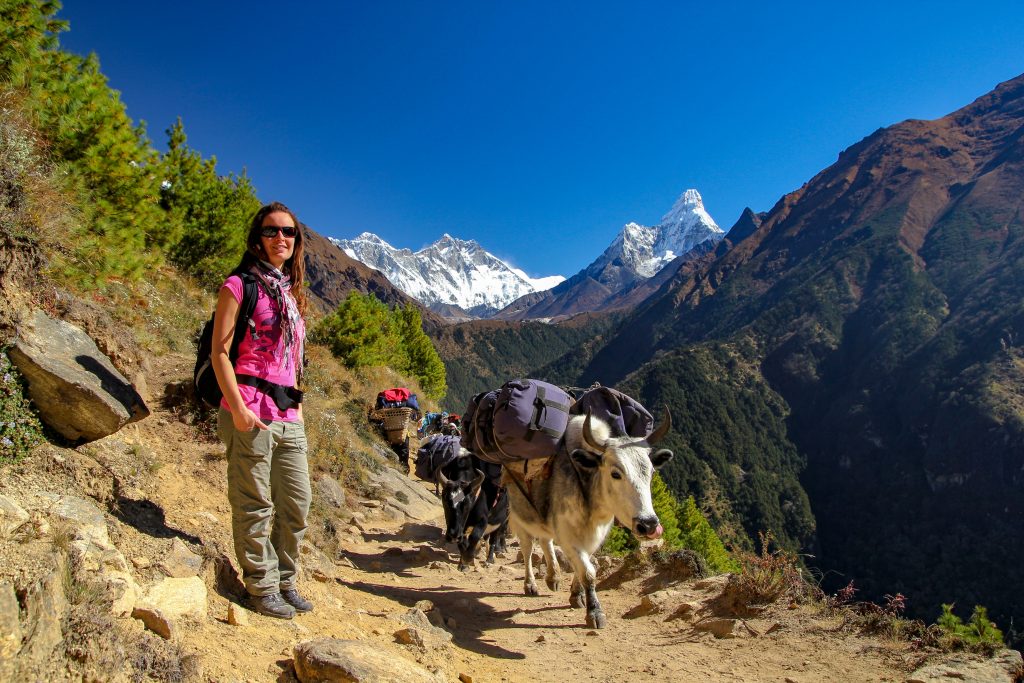
And, if you meet a yak along the way (there are plenty). Make sure to stand on the mountain side of the trek, as there has been reports of yaks accidentally pushing people off the trail. (That is a sad way to end your life.)
Phakding
 After making the proper preparations in Lukla we headed towards our first stop Phakding, where we stayed the night in a teahouse.
After making the proper preparations in Lukla we headed towards our first stop Phakding, where we stayed the night in a teahouse.
At 2640 m (8660 ft), Pakding is quite an easy start as it actually is a bit downhill. It only takes about three hours to get here from Lukla.
Had it not been for the fact that we only carried a light daypack the trek most certainly had been harder, even from the start. Instead, our heavy main backpacks were carried by sherpa porters.
I still cannot understand how the the porters manage to carry the amount of gear that they do.
They are amazingly strong. Without them on the mountain there would not be many people doing the trek, nor climbing Everest, I can tell you that.
Namche Bazaar
We started early the following day and walked the whole day until we arrived in the small town of Namche Bazaar late in the afternoon.
I was really looking forward getting here as I had read about it in the book Into Thin Air covering the 1996 Everest disaster.
If you have not read it already, I can really recommend doing so. It is a great read.
Namche Bazaar (3440 m/11286 ft) is a hub and gateway to the Himalayas.
 In Namche you will find most things that you might need for your trek. And if you have forgotten something else, that is not trek related, you will probably be able to buy it here. At least there will be no better place to look for it further on.
In Namche you will find most things that you might need for your trek. And if you have forgotten something else, that is not trek related, you will probably be able to buy it here. At least there will be no better place to look for it further on.
Besides from a lot of climbing gear Namche also has a police checkpoint, a bank and a busy Saturday Market.
There you can purchase souvenirs and other goods from traders who have come from as far away as Tibet.
If you like keep yourself somewhat clean, make sure to take a hot shower now.
Because there will not be many other chances along the rest of the trek.
Acclimatization
 We spent two days acclimatizing in Namche before continuing our journey.
We spent two days acclimatizing in Namche before continuing our journey.
The next couple of days we kept pushing forward and passed the small villages of Thame, Khumjung, Tengboche and Dingboche along the way.
On day seven we arrived in the Lobuche. It is a small outpost consisting of a cluster of rather primitive houses.
This was where we would sleep the last night before arriving at the EBC.
Not a piece of cake
Do not expect a spa resort when sleeping in Lobuche (4940 m/16210 ft).
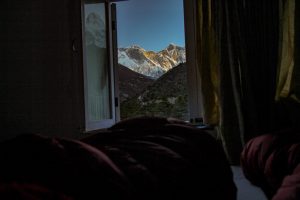
Sleeping at this altitude is definitely not as fun as it is back home.
Lying completely still in your bed, while your hart is beating as fast as it normally does when running, makes you kind of humble.
It was not the most pleasant hotel night we have had, I can tell you that.
And from the sounds of it, some people had it even worse.
When the morning finally arrived we were eager to get going as soon as possible. After Lakpa had helped us find some breakfast we were on our way again.
This time, with the end goal in sight!
Good conditions
The weather had been amazing so far, with clear blue skies almost every day.
Today there was some clouds coming in but besides from that the conditions were perfect. Not too cold and no wind.
 The trek up to Gorak Shep (5164 m/16942 ft) was only about 4,5 km long and we felt strong so we started walking in a good pace.
The trek up to Gorak Shep (5164 m/16942 ft) was only about 4,5 km long and we felt strong so we started walking in a good pace.
After a couple of hours, and just before reaching Gorak Shep, I really started to feel the altitude.
Heavier breathing and a growing light pressure on my chest made me realize that it was time to slow down.
Fariba was still perfectly fine which of course was a bit annoying, 😊. Luckily she does have her sympathetic moments and slowed down and waited for me.
Kala Patthar
Soon we had reached Gorak Shep and the foot of Kala Patthar (5545 m/18192 ft).
By now I was feeling some serious pressure on my chest and decided that this was it. No further than Gorak Shep for me.
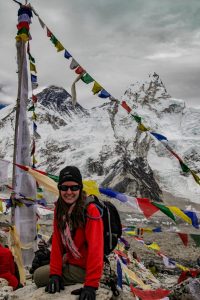
Fariba and Lakpa thought that some rest would make me feel better again. Surprisingly enough it seems that now and then even I can make rational decisions.
So despite the convincing attempts I chose not to push it any harder and decided to stay. Fariba and Lakpa were now on their own and headed towards the top of Kala Patthar.
I followed them slowly making their way up the mountain. Then they disappeared over an edge and were gone. It took almost an hour before I saw them again.
Had they made it?
Of course they made it. And they were bloody fast too!
Everest Base Camp
When they came down again the question was if we wanted to go to the actual Base Camp.
To be honest, I could not have cared less.
Luckily Fariba thought the same thing. Strange, as this was supposed to be the goal of the trip.
But, we almost saw the EBC from where we stood and it was not like we were missing out on a lot of things.
Ok, now we were not able to say, “Yes, we have been exactly on Everest Base Camp”.
Even so, I am pretty, pretty sure that the views from there are similar to the ones we had.
Because the landscape that was surrounding us was incredible!
The dark peak of Everest (8848 m/29035 ft) appearing between Lhotse (8516 m/27940 ft) on one side and Nuptse (7861 m/25791 ft) on the other.
Stay or go back?
Now that we decided not to walk to the actual EBC, did we want to stay a night in the great Gorak Shep Teahouse? (We had paid for it so why shouldn´t we, right?)
The simple answer was – Hell no!
If we did not need too, we were not staying another night at this altitude.
Instead we started racing down the mountain. We walked as fast as we could as we wanted to avoid trekking in the dark.
We actually made it all the way down to Dingboche. And the more we descended the stronger we felt.
Sleeping in Dingboche was a nothing compared to how we had been feeling just a few hours earlier.
Time to enjoy the trek
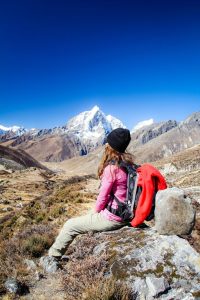 The rest of the trek back to Lukla was pleasant and nice.
The rest of the trek back to Lukla was pleasant and nice.
It got increasingly easier to breathe and we enjoyed taking our time viewing the scenery and watching other trekkers walking in the opposite direction.
They would sure would have some rough, and wonderful, days ahead of them.
In Lukla we said goodbye to Lakpa and our porter and made sure to tip them properly.
The guides and porters depend massively on the incomes from tourists as the normal salary for doing a trip like ours probably is not very high.
Take-off was better than landing
The take-off from Lukla airport was not close as scary as the landing.
Soon thereafter the wheels of our airplane touched tarmac again and we were back in Kathmandu.
No more tranquility
 The peace and quiet from the mountains abrubtly dissapeared.
The peace and quiet from the mountains abrubtly dissapeared.
Suddenly we had returned to the hectic city life. Two completely different worlds and the feelings of returning to Kathmandu were mixed.
One of the most positive things about returning to civilization was the ability to have a long, warm shower for the first time in nearly two weeks.
We loved the trek, and being a bit unwashed is part of the trek-package.
It is just that the standard of an improvised cleaning facility above 4000 meters cannot compete with a modern hotel room shower.
Unplanned journey
We spent a few days in Kathmandu recharging our batteries while thinking about what we wanted to do next.
As we still had a couple of weeks in Nepal, and no big plans besides a trip to Chitwan, we made a spontaneous decision to leave the country for a few days.
We booked a trip to Bhutan which was not part of our initial travel plan.
It turned out to be one of the most fantastic places we had ever visited.






